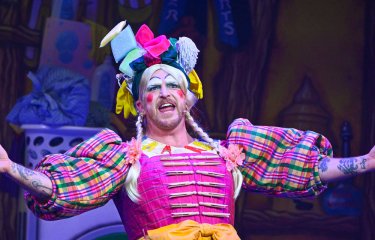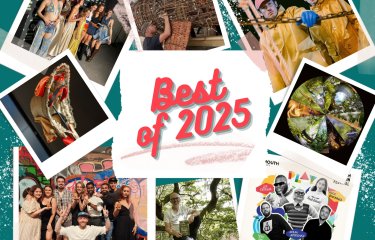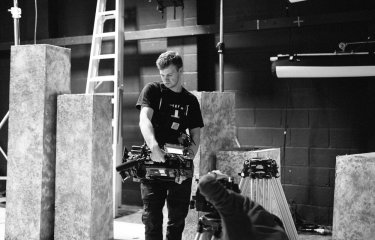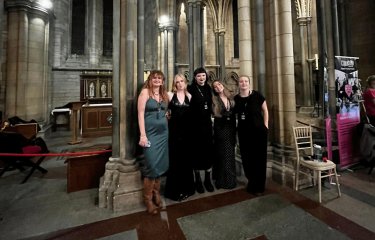Students Commissioned to Film Galapagos Land Birds
23 June 2019
Diving with sharks, snorkelling with penguins, swimming with green sea turtles and eagle rays; these were just a few of the things on the itinerary for the latest group of Marine & Natural History students visiting the Galapagos islands this year.
In addition to exploring the landscape and capturing the wildlife, the students worked with the local people and scientific community to create a film about the native land birds.
Commissioned by the scientists at the Charles Darwin Foundation (CDF), the film explores how the unique birds are being threatened by an invasive, parasitic fly. The team benefitted from privileged access to the CDF insect research labs and highland field sites; they were able to capture a variety of wildlife – including the protected giant tortoises in the highland ranches – as well as the scientists working in the labs and on site with the land birds.
This is the fourth annual visit the course has made to the Galapagos, supported by the Galapagos National Park Directorate (GNPD).
In return for exclusive access to a range of non-tourist sites and scientific research areas, which included protected and endangered species, the students and staff delivered a series of photography workshops for the GNPD park rangers and local people.
Dr Joanna Henley, Senior Lecturer on the course, led the trip.
Joanna told us: “It was a delight to take a team of truly committed, enthusiastic and professional students and see their amazingly positive reactions to the natural spectacles on these beautiful islands. All the wildlife showed up for us this year and every one of the team had a life changing experience, which makes leading the team such a privilege.”
The film will be shown alongside an exhibition of photography from the trip at Galapagos Day 2019, at the Royal Geographical Society in London on 30 October, organised by the Galapagos Conservation Trust (GCT). During the trip, the students also worked with the GCT, collecting beach clean data to contribute to their research on the impact of microplastics.
This is what our students had to say:
Samuel Whitton, student camera operator, sound recordist and interviewer:
Visiting the Galapagos was the most incredible experience of my life – I doubt anything will ever be able to top it. We saw some remarkable animals in the most spectacular places I’ve ever seen. It was truly the trip of a lifetime, filled with so many unforgettable memories.
The itinerary was amazing; we enjoyed a range of activities and visited many locations, including snorkelling off the uninhabited island of Pinzon with baby sea lions and bottlenose dolphins, kayaking with penguins and climbing a super-volcano.
A highlight was the opportunity to kayak on one of Isabella’s beautiful lagoons. It was truly breath-taking to be surrounded by crystal clear waters, alive with rays, turtles and sharks. Seeing Galapagos penguins basking on the basalt rocks was extremely exciting and we were even lucky enough to snorkel with them later that day! It was such an incredible experience.
We saw as much of the Galapagos and the local wildlife as we could – no time was wasted.
Creating a film was also an extremely exciting opportunity and it’s something I love doing. It required a lot of careful planning before the trip, but this really paid off once we were there. The shoots ran smoothly, everyone was clear on what they were doing and we got all the shots we required.
Researching the film subject of invasive species was fascinating and being well informed really helped with the film development. We were able to have intellectual conversations with the scientists and see everything I’d read about with my own eyes, which [made] the experience even more meaningful. Interviewing these extraordinary scientists and field researchers also honed my communication and interview skills.
Jake Roberts, student camera operator and sound recordist:
I thought the Galapagos trip was amazing. An unforgettable experience filled with so many memories. It’s so hard to pick a favourite moment from the trip, but it’s got to be either diving with sharks or the two days we spent kayaking and snorkelling on Isabella.
Making the film was fun; I enjoyed working with everyone and found the filming days interesting. Sound was a new thing to me so I picked up new skills, learning how to use the equipment. I feel like the trip helped me develop my photographic skills both on land and underwater, especially with shooting wildlife as it’s not something I’ve done much before.
Josephine Tyler, student photographer:
It wasn’t a trip I ever thought I would get to do; I’d love in the future to do it again! It’s not just for the animal lovers, but also great for anyone interested in the environment. There is a wide range of projects and things to see.
Emily Kennett, student film director:
The trip was absolutely incredible – very full on and tiring but so well organised.
There was a huge amount of planning and communication with CDF prior to the trip. It paid off as the filming went as smoothly as we could have hoped for. The Falmouth team were amazing and we got some incredible footage. It was really special to be able to have in-depth talks with CDF too.
The responsibility of being director, in charge of the group, alongside having to present really helped with my confidence and gave me good leadership skills for the future.
Also, while we were snorkelling, we swam with a pod of about twenty dolphins which was really unexpected. When we got back on the boat to leave, the engines started and four or five dolphins breached out of the water, almost like a goodbye.
You can see some of the students’ incredible photography in the carousel.
Student photo credits:
- Molly Rands
- Oliver Smith
- Emily Kennett
- Josephine Tyler
- Jake Roberts
- Bethany Harper
- Charlie Cupples




